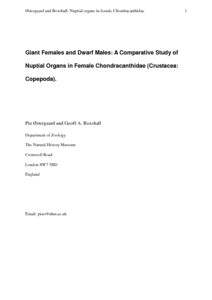Ostergaard, P; Boxshall, GA
(2004)
Giant females and dwarf males: a comparative study of nuptial organs in female Chondracanthidae (Crustacea : Copepoda).
ZOOLOGISCHER ANZEIGER, 243 (1-2).
65 - 74.
ISSN 0044-5231
https://doi.org/10.1016/j.jcz.2004.07.001
SGUL Authors: Ostergaard, Pia
![[img]](https://openaccess.sgul.ac.uk/107115/1.hassmallThumbnailVersion/Ostergaard_Boxshall_2004_Zool%20Anz_submitted%20version.pdf)  Preview |
|
["document_typename_cannot open `/data/SGUL/sgul/eprints3/archives/sgul/documents/disk0/00/10/71/15/01/Ostergaard_Boxshall_2004_Zool' (No such file or directory)
cannot open `Anz_submitted' (No such file or directory)
cannot open `version.pdf' (No such file or directory)" not defined]
Accepted Version
Download (2MB)
| Preview
|
Abstract
Male chondracanthids attach to specific structures located near the genital apertures of the female and the term nuptial organ is proposed for these structures. The morphology of the nuptial organ in Acanthochondria cornuta, A. limandae, Acanthochondrites annulatus, Blias prionoti, Chondracanthodes deflexus, Chondracanthus lophii, Lernentoma asellina and Pseudoblias lyrifera is described. Nuptial organs in C. lophii contain glandular tissue and appear capable of producing a secretion. In addition to providing a site for male attachment these organs may have other possible functions, which are discussed.
| Item Type: |
Article
|
| Additional Information: |
NOTICE: this is the author’s version of a work that was accepted for publication in ZOOLOGISCHER ANZEIGER. Changes resulting from the publishing process, such as peer review, editing, corrections, structural formatting, and other quality control mechanisms may not be reflected in this document. Changes may have been made to this work since it was submitted for publication. A definitive version was subsequently published in ZOOLOGISCHER ANZEIGER [243, 1-2, 8 Nov 2004] http://dx.doi.org/10.1016/j.jcz.2004.07.001 |
| Keywords: |
Science & Technology, Life Sciences & Biomedicine, Zoology, ZOOLOGY, parasitic copepod, morphology, ultrastructure, TEMORA-LONGICORNIS, PARASITIC COPEPODS, MATE-TRACKING, BEHAVIOR, FISHES, parasitic copepod, morphology, ultrastructure, Zoology, 0608 Zoology |
| SGUL Research Institute / Research Centre: |
Academic Structure > Molecular and Clinical Sciences Research Institute (MCS)
Academic Structure > Molecular and Clinical Sciences Research Institute (MCS) > Cell Sciences (INCCCS) |
| Journal or Publication Title: |
ZOOLOGISCHER ANZEIGER |
| ISSN: |
0044-5231 |
| Related URLs: |
|
| Dates: |
| Date | Event |
|---|
| 1 November 2004 | Published |
|
| Web of Science ID: |
WOS:000226603600007 |
| URI: |
https://openaccess.sgul.ac.uk/id/eprint/107115 |
| Publisher's version: |
https://doi.org/10.1016/j.jcz.2004.07.001 |
Statistics
Item downloaded times since 07 Aug 2014.
Actions (login required)
 |
Edit Item |


